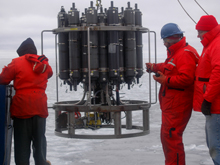
Mike Kong, Dan Torres, and Marshall Swartz stand by as the conductivity-temperature-depth (CTD) recorder, mounted to the circular rosette along with many Niskin water bottles, returns after a cast at one of the iciest stations. The CTD and associated recorders help define properties of the water samples, which helps scientists understand where the sampled water came from, and where it is headed. Click image for larger view and image credit.
Where Does This Water Come From, and Where Is It Going?
September 27, 2009
Daniel J. Torres
Woods Hole Oceanographic Institution
With Robert S. Pickart and Marshall Swartz (WHOI)
and Elena Bondareva (Arctic and Antarctic Research Institute)
Several things almost certainly occur over the course of a long cruise. A moment comes when things are going so poorly that you ask yourself, “Why do I keep coming out to sea and doing this to myself?” You think of your family struggling at home, and wonder whether it is all worth it. So why, after nearly 20 years and close to 50 cruises, do I keep coming back? It’s those "other things." The other moments in time that keep bringing me back, like a moth to a flame. Moments like standing on deck and discovering that it is possible for it to snow from the ground up. Or times like lying on your back on the flying bridge, staring at more stars than you thought existed, while Aurora Borealis ripples across the sky. Or pushing pancake ice away with long poles and Popsicle hands to prevent damage to the instrument cable, thinking it is likely that you and your colleague are the only ones on Earth doing that at that moment.
And then there are the other types of discoveries — the real reason we are out here.
I, Daniel Torres, along with Bob Pickart and Marshall Swartz from the Woods Hole Oceanographic Institution and Elena Bondareva from the Arctic and Antarctic Research Institute, am part of a physical oceanography team whose job it is to describe the water masses we work in and try to determine where they came from and where they are going. In order to do that, we are taking precise measurements of salinity and temperature using a conductivity, temperature, and depth (CTD) recorder, and velocity measurements using a lowered acoustic doppler current profiler (LADCP) system. The CTD helps define the water properties, which in turn enables us to discern the origin of the water masses we are sampling. Additionally, the CTD mounted on the rosette is used for taking water samples at various levels throughout the water column. These water samples are used to measure many other properties, such as nutrients, chlorophyll, CO2, and dissolved organic carbon (DOC).
But that only tells part of the story. The LADCP system also provides a direct measurement of the water velocity. The LADCP transmits an acoustic pulse (like a sonar) at a fixed frequency. Then it "listens" for the return echo. The change in frequency of the return echo (also known as the Doppler shift) is proportional to the water velocity. Three beams oriented at different angles are necessary to attain a three-dimensional measurement of the velocity structure throughout the water column. Knowing the water velocity helps us determine where the water masses came from, where they are going, and how they change over time, which is why it is important to repeat these surveys every few years (or even more frequently).
Understanding the velocity and water mass structure also play an essential role in interpreting the property and biota (plant and animal) distributions being measured by other scientists on this mission. Modern instrumentation allows us to make these measurements with an accuracy and resolution never before possible.
It is very exciting to be a part of a scientific team working to gain a better understanding of a previously sparsely measured environment in an ever-changing Arctic. With every station we take, another piece of a large puzzle is put into place. And with three days left on this cruise, I am still waiting for that moment where I wonder why I am out here doing this to myself — so we must be doing something right!















